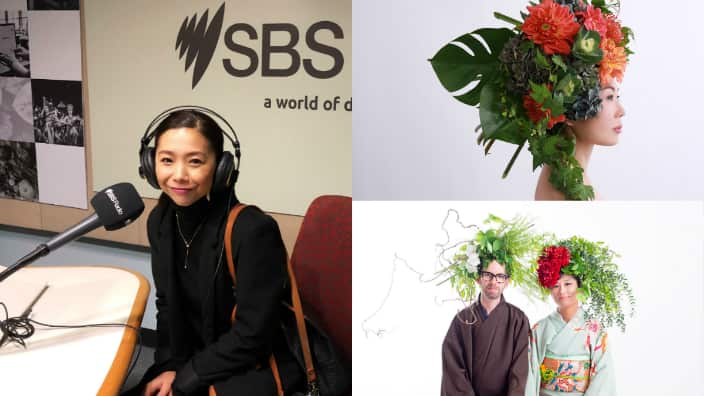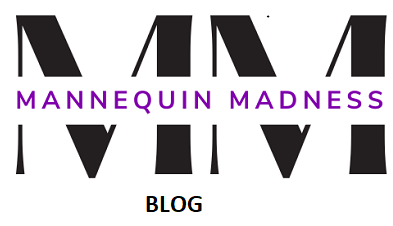
This article below about turning humans into flowers caught my attention because it reminds me of a new service we started at Mannequin Madness. We didn’T realize we are part of a trend when we started making headdresses as few years ago.
We had received some mannequin heads from a cosmetology school at the same time we received a huge assortment of faux flowers from the Macy’s Flower show when we recycled their mannequins.
So we decided to use the flowers to make headdresses on the heads and display in our warehouse. Customers who came to our warehouse to purchase mannequins were attracted to the headdresses and asked to buy them. But the flowers were glued to the heads!
This sparked our idea to open up our space and offer headdress classes class so people could make their own headdress. Kinda like paint and sip, but instead of making art for the wall, it is art you can wear. You use a glue gun versus a paintbrush and a mannequin head is the canvas. We called it TheHeaddressWorkshop.com.
Our customers make some amazing designs similar to what this artist is doing. However we offer faux flowers & foliage instead of real flowers so that people can wear their headdress over and over again. We agree with the idea of “making our clients bloom” as this artist is doing on Australia.
In addition to offering this in our showroom, we offer it as a team building activity to companies throughout the SF Bay Area. It is a creative and interactive way to have a conversation about diversity. Especially at the end of the class when do a photoshoot. We also give people a chance to do a video to record what the process of making the headdress was like for them and why they chose that design.
Yuka Konno has turned her lifelong love of flowers into a career, taking up the practice of hananingen to create ‘human flowers’.
Yuka Konno’s blossoming Sydney business is the first hananingen studio in Australia, as the recently emerged Japanese style spreads across the world.
Hananingen is a Japanese term consisting of two words, flower (‘hana’) and human (‘ningen’), literally translating to ‘human flower’. This style of arranging fresh flowers on people’s heads was created by Japanese flower artist Hikaru Seino in Sapporo in 2014 and has become popular throughout Japan.
There are now seven hananingen studios in Japan, one in Thailand, and of course, one in Sydney, Australia.
Due to its popularity, clients are required to now book up to two months in advance to take on a hananingen style, which they often do for weddings or highly styled photoshoots.
‘We make our clients bloom’
“Flowers are beautiful, and each person has their own beauty as well,” Yuka tells SBS Japanese. “I want to combine them through Hananingen. We make our clients bloom with flowers and highlight the amazing qualities they already have.”
In Yuka’s Hananingen Sydney studio, a client will have their makeup done and pick one favourite flower to start. Then Yuka takes over and starts making a flower arrangement on the client’s head. The client is not allowed to look in the mirror until the arrangement is done. The surprise felt by clients after the transformation is part of the experience, and helps clients feel a sense of unity with flowers, says Yuka.
“After the make-up and flower arrangement, we take a professional photo of the client to capture the unified beauty of the flowers and the client. I think that I can call the whole process art,” she says.

Yuka says her floral creations bring their subjects closer to nature and the flowers they love Source: Yuka Konno
‘I decided to enjoy my life for myself and my family’
Yuka says she has always loved flowers and wanted to do something more than just decorating her house with them. When Yuka was searching for a way to respect flowers and celebrate their beauty and live her life in a fulfilling way, she found the hananingen style on social media.
At that point she hadn’t worked professionally with flowers and worked in an entirely different industry. Before she turned 40 her health had deteriorated due to work stress, so she took the leap to enroll herself in a florist school.
“I also started learning make-up and photography to start all over again,” she says. “I didn’t want to ruin my health again and I wanted to show my two kids how much their mum enjoys her life.”
Connecting people to flowers
Asked what her own floral preference is, Yuka says her favourite flower is the scabiosa or pincushion flower. “I like it because it can draw out the beauty of other flowers.”
It is Yuka’s own love for flowers and the deep connection she feels to them that motivates her work.
“When you’re looking at flowers in a vase, you can enjoy their beauty but that’s it,” she says. “But if you are with flowers and witness that the flowers are part of you and highlight your beauty, you start to have more intimate feeling towards them. That’s Hananingen. It was created to connect people with flowers.”
“Flowers give us unconditional love. Why don’t we start respecting them more and love them back?”
